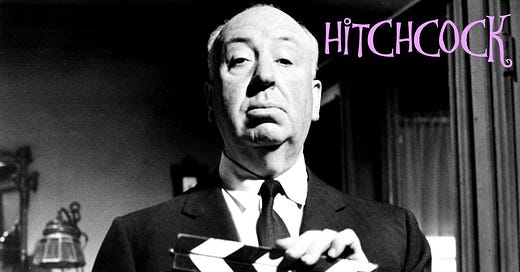If you know me, you know that I am a big fan of old Hollywood, the era of black and white films. It was an era where storytelling was superb and movies didn’t rely on special effects to get their point across. No big summer blockbusters, just great movies. In writing circles we have a saying…show, don’t tell. That mantra was on full display in old Hollywood, especially in the beginning with silent films.
Alfred Hitchcock, the undisputed Master of Suspense, revolutionized cinema with his storytelling prowess, beginning in the silent film era (Blackmail) and evolving into one of the most influential directors in the history of cinema. His films are as thrilling today as they were decades ago. I truly hope that young audiences will appreciate the work of this era. In a world dominated by fast-paced digital content and CGI-laden spectacles, Hitchcock's meticulous craftsmanship, psychological depth, and visual storytelling offer a refreshing and timeless cinematic experience. I am proud of my large DVD collection of his work that goes all the way back to the silent era.
Speaking of the Silent Era…
Hitchcock’s career began in the silent film era, an often-overlooked period that shaped his mastery of visual storytelling. Silent films relied heavily on imagery, composition, and movement to convey emotion and tension. Tension…the key to every great story. Hitchcock was able to embrace this limitation and turned it into an advantage. His early works, such as The Lodger: A Story of the London Fog (1927), showcase his ability to create suspense without dialogue, using striking visuals to build tension.
This foundation in silent cinema made Hitchcock a master of “pure cinema”—the idea that the essence of film lies in its visual language rather than words. His later masterpieces, such as Psycho (1960) and Rear Window (1954), are filled with moments of silent tension where the audience is left hanging on the edge of their seat, proving that sound is often secondary to storytelling. If you haven’t experienced these films you are certainly missing out!
While modern audiences are accustomed to rapid-cut editing and heavy-handed exposition, Hitchcock's approach to storytelling was deliberate and psychological. His films invite viewers to engage with the narrative, piece together visual clues, and experience suspense in real-time! Just watch Vertigo and you’ll know what I mean.
Hitchcock didn’t just rely on shocking twists. He built suspense by manipulating audience expectations. In Vertigo (1958), he explored obsession and identity, crafting a mystery that unravels gradually, forcing the audience into the protagonist’s unstable psyche. In Psycho, he defied conventions by killing off the main character early in the film, shifting the narrative in an unexpected direction. These techniques remain effective, keeping viewers invested long after the credits roll.
Hitchcock pioneered numerous techniques that continue to influence filmmakers today. The infamous “dolly zoom” shot in Vertigo—where the background stretches away from the subject—is still used to convey disorientation and dread. His use of point-of-view shots, particularly in Rear Window, immerses viewers in the protagonist’s perspective, making them complicit in the act of voyeurism.
Hitchcock’s influence extends far beyond his own era. Directors like Steven Spielberg, David Fincher, and Christopher Nolan have all cited him as an inspiration. His ability to craft tension and engage audiences without excessive dialogue or effects remains unparalleled. For young filmmakers and cinephiles, studying Hitchcock is akin to taking a masterclass in the art of storytelling.
In an age where many films prioritize spectacle over substance, Hitchcock’s work serves as a reminder of what makes cinema truly great: compelling stories, masterful direction, and psychological depth. Whether it’s the slow-burn tension of Notorious (1946), the eerie paranoia of The Birds (1963), or the macabre humor of Strangers on a Train (1951), there’s a Hitchcock film for every kind of movie fan.
For younger audiences that love mystery, thrillers, or psychological horror, his films offer an experience that no modern remake or CGI-laden blockbuster can replicate. His work never goes out of style.
Hitchcock didn’t just make movies—he crafted experiences that linger in the mind long after the screen fades to black. For young audiences willing to explore his films, a treasure trove of suspense, innovation, and masterful storytelling awaits.





I started this post minutes ago. It must wandering around in Never Never Land. Any way, the genius of Alfred Hitchcock is well explained here. I just returned home from a walk with a friend. During the walk, she spotted a dozen crows perched on the top of a house. Immediately upon spotting them, she referenced Hitchcock's The Birds. Once your seen a Hitchcock movie, you'll not soon forget it. What a master. Plus, it's fun to see if he's playing a cameo role.